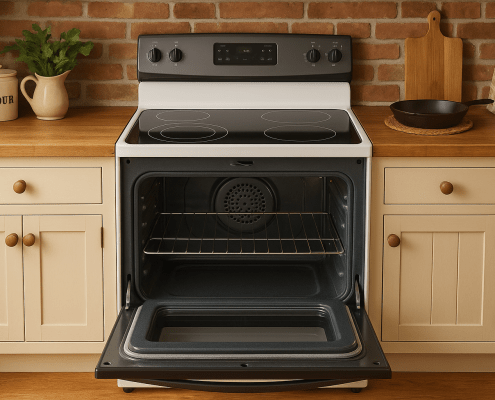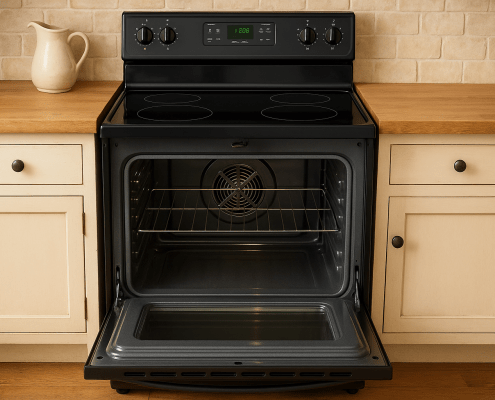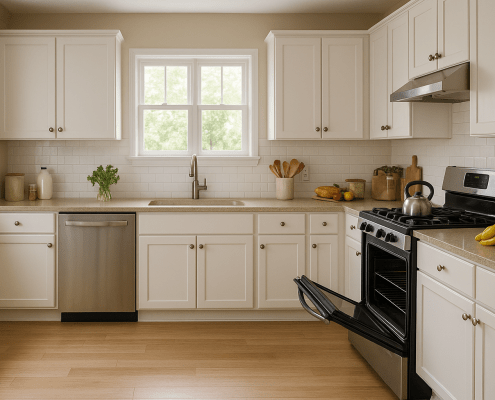Why Your Stove Cooktop Element Stays on High Heat
Steven E / Wednesday April 23, 2025
You go to preheat the pan to start cooking, only to find that your range’s surface element isn’t heating up no matter how high you turn the dial or it will only go to a high setting. Especially when you’re in a hurry to get dinner on the table. But don’t panic just yet—there’s usually a simple explanation for why your electric range surface elements aren’t heating properly. Let’s go through what parts you will need to check to correct this issue and how to test them.
If you find out that you need any replacement parts for your range while you’re troubleshooting, you can enter your model number at AppliancePartsPros.com to order them. Most orders arrive in just two business days, and we have thousands of free guides to show you how to install your new parts.
The information in this article may not apply to your specific appliance model. We recommend consulting your manufacturer’s documentation or contact us with any questions.
Safety precautions
When working on any appliance, remember to keep safety first. Here are some tips to keep in mind:
- Always power off and unplug your appliance or switch off the circuit breaker before attempting any maintenance or replacement work. This keeps you safe by preventing any risk of injury from electric shock.
- Wear insulated work gloves to protect your hands from sharp metal parts, pinching hazards and debris.
- Take your time and don’t rush while working to prevent accidents and personal injuries.
- Work in a well-lit area so you can clearly see and access the interior parts.
- Clear your workspace of clutter and other obstacles. Keep children and pets away from the work area.
- Never work on internal parts with bare wet hands. Make sure the work area is completely dry.
- Check your user manual to see if there are specific installation or safety instructions for your part or appliance.
- Be gentle when handling or removing parts. Excessive force might damage the appliance or cause injury.
- Wear safety glasses when working with chemicals, dust or cleaning large debris to prevent injury.
- If the appliance has recently been used, give it plenty of time for any heating parts to cool down before working on it.
- Take pictures or make a note of wiring terminals or other connections before disconnecting to prevent any problems with reassembly.
- When working with wires, avoid touching any exposed wires or terminals. If you need to touch a wire, use a non-conductive tool or wear insulating gloves to prevent electrical shock.
Possible causes
You will need to check each possible problem area to narrow down where the issue lies. Let’s break down the main components that could be to blame:
- The surface element. Physical damage, cracks in the heating coils, or contact failures can inhibit heat transfer.
- The connection points. Problems at the burner sockets, terminal blocks or wiring could disrupt power delivery.
- The control switch. Issues with infinite switches may prevent precise temp control.
- The control knob. A damaged knob can prevent the switch it attaches to from being adjusted.
Troubleshooting steps
Step 1: The knob
- Examine the surface element knob closely for any visible damage, such as cracks, discoloration, or loose connections. If you notice any significant damage, the knob may need to be replaced.
- Depending on the specific model of your stove or cooktop, removing the knob may involve pulling it straight off or twisting it counterclockwise. Refer to the appliance’s user manual for precise instructions on how to remove the knob safely.
- Look for any debris, such as food particles or dirt, that may be obstructing the knob’s movement or preventing it from making proper contact with the underlying temperature control mechanism. If you find any debris, carefully clean it using a soft cloth or a small brush.
Step 2: Surface element
- Make sure that you have disconnected the power source from your appliance before beginning.
- Lift the main top of your appliance in order to locate the surface burner element. Once you have found it, remove it in order to test it. You should also visually inspect it for any signs of bubbling, burning, wear, holes, or damage.
- To test for a shorted element, touch each of the terminals one at a time with one probe while holding the other probe to the outside surface of the element. If either terminal show continuity, it is defective.
- To test the entire element for resistance, place each of the probes on the terminals, one on each. The exact reading you should receive varies between models, refer to your owner’s manual to determine what yours should be, but if any element has a reading outside of 19 to 115 ohms generally, it is defective.
Step 3: Connection point
- Before testing the element, make sure to inspect the wiring and terminal blocks for any issues. Problems occurring in these areas can cause interruptions in power delivery.
- Look out for burn spots, loose connections, or any other signs of damage.
- You can also test the wires for continuity with a multimeter. If the wires do not have continuity there is a short in the wiring and will need to be replaced.
- If damage is detected on any of those parts you will need to replace the affected parts.
Step 4: Infinite switch
- Test for continuity between the switch contacts: Remove all wires from the switch terminals. (Remember to label them or take pictures!)
- Set the infinite switch on high and place your mulitmeter on the L2, H2, P and H1 terminals to check for continuity.
- If there is no continuity between L1 and H1 or between L2 and H2, the infinite switch is defective.
- If there is no continuity between P and H1, the indicator light circuit is defective.
- Remove the infinite switch by removing the screws or nuts that hold it in place and install a new infinite switch by following the disassembly instructions in reverse order. Be sure to follow the wiring diagram and install the wires to the correct terminals.
Additional information
Thank you for reading! We hope this guide helped you get your range working again.
If you have any other appliance repair needs or projects, don’t hesitate to explore our other troubleshooting guides and videos.
If you need replacement parts or some extra help with ordering them, grab your model number and head over to AppliancePartsPros.com, where you can chat with a pro, read our DIY blog and more.
With nearly a decade of experience in providing top-notch customer service regarding appliance parts and repair, Steven enjoys sharing practical advice, troubleshooting tips, and interesting information to help readers stay informed.





